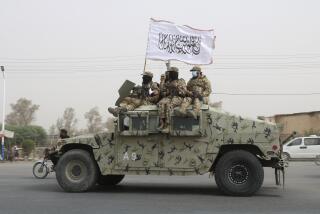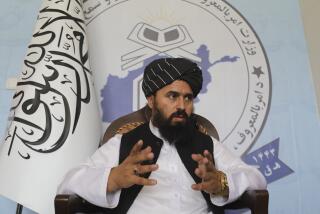War’s Newest Combatants Take Devotion to Streets
- Share via
KANDAHAR, Afghanistan — The unsmiling young men in turbans and Muslim prayer caps kicked up dust as they strode through the bazaar, their determination evident in their gait. At one of the street-front stalls, they wheeled, entered and emerged carrying an affront to their interpretation of Islamic morality.
It was a small television set, which the mullahs of the Taliban movement have denounced as haram, or impure, because the Hadith--the deeds and sayings of the Prophet Muhammad--contains a ban on images.
Since Nov. 4, 1994, Kandahar, the old royal capital of Afghanistan in the country’s southeast, has been under the prudish, repressive rule of the ultra-orthodox Taliban, the newest participants in Afghanistan’s civil war.
In part because of covert support from neighboring Pakistan, the Taliban now control 14 of the 30 Afghan provinces. Their avowed goal is the overthrow of President Burhanuddin Rabbani’s nominal government and its replacement by a modern-day Muslim caliphate paying strict obedience to the Sharia, or Islamic law.
Pushed out of Kabul in October, but still only 10 miles from the capital, the Taliban are so dreaded by their enemies that guerrilla leader Gulbuddin Hekmatyar has now thrown in his lot with Rabbani’s government, which he had been fighting to destroy.
The day the 46-year-old fundamentalist entered a power-sharing arrangement with Rabbani, Taliban fighters showered Kabul with rockets, killing more than 30 people.
The Taliban are the children of the anti-Soviet struggle in Afghanistan and the more than four years of civil war that have followed. Drawn in large part from madrasas, or religious schools, in Afghanistan and Pakistan, where 1 million Afghan refugees still live, and often knowing little save a dose of Koranic verses and how to use AK-47 assault rifles and other modern weapons of war, they are the newest generation of battle-hardened fighters to be forged in the heat of the Afghan conflict.
To anyone who has followed this Asian country’s ongoing tragedy, one question that comes to mind is: What will these boys and young men be doing in five or 10 years?
“We will go on to fight the murdering leaders of other countries,” was the quick answer of Muhammad Musa, 18, a Talib who was recruited to the force at a madrasa in the Pakistani port city of Karachi.
“We want the Koran to triumph throughout the globe,” another Taliban fighter added.
Both youths had been wounded in action around Kabul and evacuated to a 280-bed hospital for war victims run by the International Committee of the Red Cross in Quetta, Pakistan, across the border.
Musa, who had been pierced by shell fragments as he rode atop a tank southwest of the capital, lay gloomily on his camp bed and said he could not wait to get back to the front, “for the sake of Islam’s freedom.”
In areas now under their control, the Taliban smash car radios and tape players if drivers are rash enough to switch them on--music is also haram--lop off any thief’s hand and shoot murderers in the city bazaar or other public places, with relatives of victims sometimes invited to pull the trigger.
These moralistic fighters, who have established their capital in Kandahar, have forbidden women from working, even for agencies of the United Nations, and have kept girls’ schools shut while reopening classrooms for boys.
Soccer was also banned by their imams as un-Islamic, until the sports-crazy people of Kandahar pointed out that the Koran and Hadith make no specific mention of the game.
The Taliban have also shown themselves as exceedingly pragmatic when it comes to the growing of opium poppies, a crop they have said they firmly oppose but one that is an economic mainstay in much of the war-devastated lands under their control.
Though they have busted a few drug traffickers to show their displeasure, the Taliban, say officials of the U.N. Drug Control Program in Islamabad, the Pakistani capital, have done nothing to stop poppy cultivation by farmers who often are their supporters and who have no alternative source of livelihood.
For the past three years, according to the U.N. agency, Afghanistan has become the world’s leading source of opium--the raw material of heroin.
This year, Afghanistan should yield 2,600 tons of opium grown on 150,000 acres, roughly half of which are under Taliban control, the U.N. drug control program has estimated.
The Taliban’s brand of Islam is severe for even a poor, illiterate and tradition-bound land like Afghanistan.
But to some inhabitants of this city--an eerie patchwork of houses and buildings that have been pounded to rubble by the war, but also home to some of Afghanistan’s most beautiful and historic monuments, adorned with glazed tiles of blue, turquoise, green and yellow--the change is welcome.
The local commanders of the moujahedeen--the Muslim “holy warriors”--in Kandahar used to abduct young boys for homosexual trysts. Traders were regularly forced to pay tribute and were beaten if they failed to do so. Such abuses have now stopped, residents say.
“When the moujahedeen were here, they used to extort money from me and beat me,” said Haji Turiali, 32, who owns a small pharmacy. “The Taliban take nothing.”
The Taliban--the name derives from the Arabic word for divinity students, literally “seekers”--demand that every woman wear a burqa, a sort of billowing tent that covers the body from head to toe, when she ventures out of her home. Yet because of the sense of security restored to Kandahar, many more women now come to the market.
With their murderous rocket attacks on Kabul, the Taliban have earned the hatred of many Afghans and have lost much of the sympathy and pristine reputation that the status of religious students once gave them.
Still, in Kandahar, as one resident observed, “Now you could put a sack of flour on a bicycle, leave, and both would be there by evening.”
Last autumn, when the Taliban suffered a series of losses at the hands of former moujahedeen commander Ismael Khan, and Kandahar seemed in danger of falling, alarmed residents lined up to make donations.
Poor people gave a salwar kameez, a man’s long shirt plus flowing pants that is typical Afghan male dress, or a few bullets for a Kalashnikov assault rifle.
One merchant--grateful for the order reestablished by the Taliban that allows him and other traders to import tires, electronic goods and automobiles by road from Iran and the Persian Gulf, then ship them to Pakistan--ponied up 600 million afghanis, or about $50,000.
But uncertainty about the ultimate goals of their new rulers, and the identity of whom they in turn might be working for, makes some people uneasy.
“We are not sure what is in the mind of these mullahs, you know,” said one 69-year-old man who worked for the Americans when they built a road between Kabul and Kandahar and the city’s airport in the 1950s. “Before, we used to shave and wear suits. But the mullahs don’t like that.”
As if professing hope about the future, some Kandaharis have reopened small eateries or roadside stalls selling produce, including the finger-like grapes and the pomegranates that grow in this green and fertile oasis zone near the Arghandab River.
In six months, the number of rickshaws for hire rocketed from two to 600. Some optimists have even replaced shattered windows.
However, as for Afghanistan as a whole, where 1 million people perished during the Soviet occupation and where today’s gruesome power struggle continues with no end in sight, what must be done to restore anything approaching normal life is staggering.
Kandahar alone is home to 10,000 war orphans and 3,000 people who lost one or both legs to mines. There are only a score of doctors for a population of 300,000 menaced by ailments from cholera to yellow fever. Fields around the city are still salted with thousands of land mines.
According to the U.N., the Taliban now have about 50,000 men and boys under arms, including many veterans of the uprising against the Communists. And there is no shortage of new recruits.
Hedayatullah Khan, hereditary chief of a Pathan tribe living in the juniper-dotted hills of neighboring Pakistan, will not let boys from his 9,000 households study in local madrasas run by fundamentalist political parties, for fear they will end up here on the battlefield.
“These so-called schools are nothing but recruiting stations for going to Afghanistan as Talibs,” the chief said. “They don’t teach them truth or religion. They involve the youth in politics and fighting.”
At Quetta’s Surgical Hospital for Afghan War Wounded, ambulances one evening rushed in more than a score of Taliban who had been shot or wounded by shell bursts in the fighting around Kabul.
Their bandages drenched in blood, the wounded, some of whom were in shock or barely conscious, were eased onto stretchers and carried as gingerly as possible into the operating room. As evidence of the stoicism for which Afghans are renowned, there was little sound from the injured.
An American reporter watched. A Taliban leader came up to him and smiled.
“From the Koran will come the power that destroys you,” the Afghan said.
(BEGIN TEXT OF INFOBOX / INFOGRAPHIC)
The Battle Goes On
Fighting continues in Afghanistan more than seven years after Muslim resistance fighters succeeded in driving out the Soviet army. Now the warfare rages among different Islamic factions.
Key events in Afghanistan since the Soviet-backed government of President Najibullah stepped down in 1992:
June 1992: Guerrilla leader Burhanuddin Rabbani is named president. Though the most peaceful transition of power in Afghanistan since 1901, the transfer comes amid fierce fighting among rival Islamic factions.
August 1992: Hundreds of foreign diplomats and their families flee the capital amid escalated artillery and rocket attacks on the city by Muslim rebels.
March 1993: Leaders of eight rival Afghan military factions announce a peace agreement in Islamabad, Pakistan.
May 1993: Rival Afghan factions renew fighting for control of Kabul; at least 700 people are killed in the first six days of the ongoing battle.
June 1993: Gulbuddin Hekmatyar, leader of the Hezb-i-Islami party, is sworn in as premier.
October 1993: About 200 people die during fighting in Kabul and in Jalalabad and Sarobi, east of Kabul.
June 1994: Forces loyal to President Rabbani direct massive strikes against positions held by Hekmatyar.
September 5, 1995: The opposition Taliban militia captures Herat, a strategic western city, as government troops flee without firing a shot.
November 1995: Taliban forces launch an air raid on Kabul, killing 35 civilians and wounding 140. The Taliban seek to capture the capital and impose strict Islamic rule over the nation; by the end of the month, they control more than half the country.
June 1996: Hekmatyar enters power-sharing arrangement with Rabbani. The Taliban launch a deadly assault on Kabul; more than 30 people are killed.
Sources: Times staff and wire reports; Facts on File
More to Read
Sign up for Essential California
The most important California stories and recommendations in your inbox every morning.
You may occasionally receive promotional content from the Los Angeles Times.













